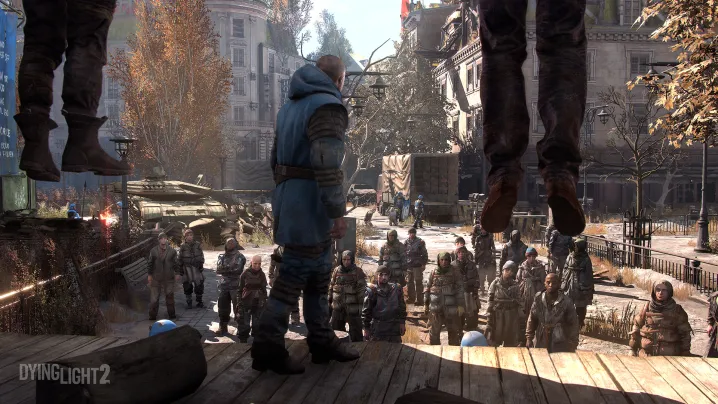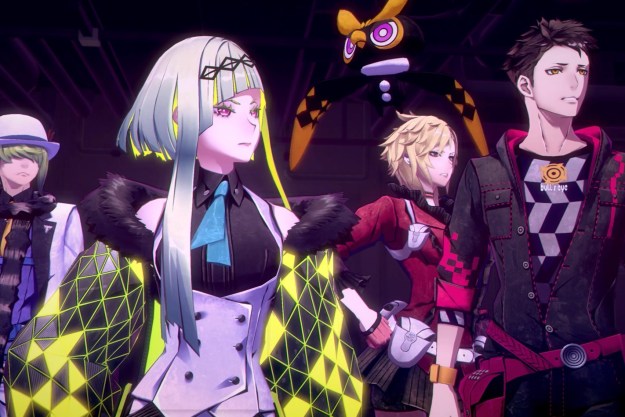
The coolest thing about Dying Light 2 isn’t exploring a huge, zombie-filled open world — it’s changing it.
Developer Techland showed Dying Light 2 in action in a hands-off demo for journalists at E3 2018, and explained that the game isn’t just a gameplay sandbox, but also a “narrative sandbox” as well. The game world is full of stories for players to find as they encounter other people, both friendly and not so much, as they try to survive years into the end of the world. How you choose to resolve those stories will affect the game world, and in Dying Light 2, that could mean some sweeping changes to how the city around you develops and survives (or doesn’t).
Lead Game Designer Tymon Smektala explained that in Dying Light 2, you’ll work your way through a fictional ruined city in what the developer calls the “modern Dark Ages,” where humans still live in small groups tiny settlements among the undead 15 years after the events of the first game. Zombies are mostly nocturnal, so humans can get around during the day, looting the city, fighting and killing each other, and finding ways to keep going.
You’ll work your way through a fictional ruined city in what the developer calls the “modern Dark Ages”.
At E3, Techland played a live demo in which the protagonist character had heard about a nearby water tower that some people had started fixing up. One of the several factions in the city, a law-and-order, semi-fascist group called the Peacekeepers, and in hopes of forming a connection with the group, the player headed of to find the tower and find out what happened to the Peacekeepers’ envoy. The path to reach it takes players parkour-ing through the city, dodging roving bands of hostile bandits as they go about their own business.
It’s a tough climb to make it to the top of the water tower. Once there, though, the player discovers that two survivors have, in fact, set up shop there. The pair are working to get the tower working to dispense water to the surrounding area. They say they did meet with the emissary from the Peacekeepers, they say, but didn’t like his offer. The Peacekeeper took a walk, they say — out an open window.
Shaping the game world
This is where the narrative sandbox kicks in. You still have your current goal — get in good with the Peacekeepers — but working with these two dubious entrepreneurs could be lucrative. Maybe you think you should make them pay for what they’ve done; maybe you’re not a fan of executing people. However you feel about it, you have to make a choice: Make a deal with the two water tower guys and spare their lives, or serve them justice. Both choices create major consequences for the story, and for the world around the area. In the demo, Techland showed both potential outcomes.
First, the justice route: The player sliced off the head of one enemy, and then (somewhat poetically) booted the other off the side of the tower after a protracted fight. Techland used the moment to show off how it has improved artificial intelligence and enem combat capabilities, with one of the fighters changing his stance in the middle of the battle, and thus the ways he might come at you, before the player used an overhead pipe to get the momentum necessary to kick him off the tower. The scene cut to some time late — what the developers described as “a few weeks” in game time — to return to the tower after handing it over to the Peacekeepers.
Choices create major consequences for the story, and for the world around you.
The improvement was notable. With the powerful, law-abiding Peacekeepers running the show, the area had been cordoned off and made safe, with infrastructure added to the entire section of the city to make it easier to get around. Most notably, the Peacekeepers made water publicly and freely available to everyone, which means you could stop by a fountain and get a drink. In practical gameplay terms, that drink provides the player with a little bit of healing if they’ve been hurt on their travels. The stability of the area has drawn others, who have strongholds and settlements in buildings in the area, all of which players can visit, interact with, or possibly tangle with.ik
The Peacekeepers had done a lot of good for the community around the water tower, but it wasn’t all positives. The Peacekeepers go hard on the idea of order, and that means they demand full compliance from the local survivors. Signs around the tower warned of the dire consequences of breaking the law. Nearby, one such offender was about to be hanged, and as other survivors look on, they commented on how the Peacekeepers don’t bother with things like trials.
Choose to work with the two guys in the water tower, and everything in the area becomes completely different. The Peacekeepers largely leave the area alone, with no foothold in it, so there’s no new infrastructure to make it easier to climb and get around. There’s also no free-flowing water. Instead, the guys who run the tower sell water to the nearby locals. The whole area is less safe — but it might be a little more free. And since you made a deal to help the water tower get up and running, you share in the profits with your partners.
As with the Peacekeeper-controlled version of the area, the water tower has drawn other settlers, but maybe of a different type than those who lived within the influence of law and order. The biggest change resulting from player choice was a new place called La Puerta. Since there’s no law here, the area has given rise to what’s basically a big black market. That place can’t exist with the Peacekeepers around, and neither can whatever potential stories and goods you might find there.
Sharing your world
Smektala says it’s making a big commitment to the story in Dying Light 2, and has recruited writers who worked on CD Projekt RED’s The Witcher 3, as well as Chris Avellone, well-known for writing on games such as Pillars of Eternity, Fallout: New Vegas and Star Wars: Knights of the Old Republic II. How you interact with the story will shape the game world in a number of ways, the developers said, and different players will end up with different worlds and different story experiences.
Like its predecessor, Dying Light 2 supports cooperative play with up to four people, but with the game world being altered by story choices so much, jumping into the middle of the game with someone else could potentially be troublesome.
The problem is solved, Smektala explained, by making each person’s game world persistent and discreet, and requiring one person to host a co-op game to keep things consistent. That means that if you play cooperatively with other people, you’ll be jumping into their particular game world, complete with their choices, and you can bring other people into your world and show them what you’ve made of it. Only the person hosting the game can make story choices when playing in co-op, so Dying Light 2 won’t track your progress through the story in someone else’s game world. It will keep track of your character progression, though, as you level up and unlock new abilities. After story choice start to stack up, though, playing cooperatively will allow players to visit alternate universes, where choices and their impacts might have gone differently than in their games.
Playing cooperatively will allow you to visit games where the world might have evolved differently.
Techland sounds like it’s taking its story approach to Dying Light 2 very seriously. With plenty of open-world games in the offing this year, Dying Light 2‘s approach to player choice and the sweeping changes that can result from it should help it stand out from the field, and it may well set a new standard for how games tackle the effects of player choice.
Dying Light 2 doesn’t have a release date yet, but is set to release on PlayStation 4, PC and Xbox One.
Editors' Recommendations
- You can play as Resident Evil 4’s Leon Kennedy in Tekken 8 … sort of
- You can get Dying Light: Enhanced Edition for free this weekend
- You can now customize your Xbox Elite Series 2 controller with Design Lab
- Hello Neighbor 2 offers impressive open-ended puzzling and one creepy villain
- Wo Long: Fallen Dynasty has a new demo. Here’s where and when you can play it








